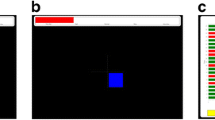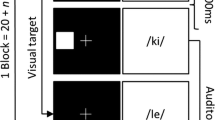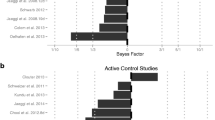Abstract
Cognitive training aims to produce a durable transfer to untrained abilities (i.e., far transfer). However, designing effective programs is difficult, because far transfer mechanisms are not well understood. Greenwood and Parasuraman (Neuropsychol 30(6):742–755. https://doi.org/10.1037/neu0000235, 2016) proposed that the ability to ignore distractions is key in promoting far transfer. While the authors identified working-memory training based on the N-back task as an effective way to train distraction suppression, a recent meta-analysis concluded that this form of training rarely produces far transfer. Such inconsistency casts doubt onto the importance of distraction suppression in far transfer and calls for further examination of the role of this ability in cognitive training effectiveness. We propose here to conceptualize distraction suppression in the light of the load theory of attention, which distinguishes two mechanisms of distractor rejection depending on the level and type of information load involved: perceptual selection and cognitive control. From that standpoint, N-back training engages a single suppression mechanism, namely cognitive control, because it mainly involves low perceptual load. In the present study, we compared the efficacy of N-back training in producing far transfer to that of a new response-competition training paradigm that solicits both distraction suppression mechanisms. Response-competition training was the only one to produce far transfer effects relative to an active control training. These findings provided further support to Greenwood and Parasuraman’s hypothesis and suggest that both selection perception and cognitive control need to be engaged during training to increase the ability to suppress distraction, hence to promote far transfer.








Similar content being viewed by others
Data availability
Data and stimuli are available from the corresponding author upon reasonable request.
Code availability
Analysis code is available from the corresponding author upon reasonable request.
References
Altarelli, I., Green, C. S., & Bavelier, D. (2020). Action video games: From effects on cognition and the brain to potential educational applications. In S. Thomas, D. Mareschal, & I. Dumontheil (Eds.), Educational Neuroscience (1st ed., pp. 273–297). New York: Routledge. https://doi.org/10.4324/9781003016830
Au, J., Sheehan, E., Tsai, N., Duncan, G. J., Buschkuehl, M., & Jaeggi, S. M. (2015). Improving fluid intelligence with training on working memory: A meta-analysis. Psychonomic Bulletin & Review, 22, 366–377. https://doi.org/10.3758/s13423-014-0699-x
Bavelier, D., Achtman, R. L., Mani, M., & Föcker, J. (2012). Neural bases of selective attention in action video game players. Vision Research, 61, 132–143. https://doi.org/10.1016/j.visres.2011.08.007.
Beck, D. M., & Lavie, N. (2005). Look here but ignore what you see: Effects of distractors at fixation. Journal of Experimental Psychology: Human Perception and Performance, 31(3), 592–607. https://doi.org/10.1037/0096-1523.31.3.592
Bherer, L. (2015). Cognitive plasticity in older adults: Effects of cognitive training and physical exercise. Annals of the New York Academy of Sciences, 1337(1), 1–6. https://doi.org/10.1111/nyas.12682
Boot, W. R., Kramer, A. F., Simons, D. J., Fabiani, M., & Gratton, G. (2008). The effects of video game playing on attention, memory, and executive control. Acta Psychologica, 129(3), 387–398. https://doi.org/10.1016/j.actpsy.2008.09.005
Brehmer, Y., Westerberg, H., & Bäckman, L. (2012). Working-memory training in younger and older adults: Training gains, transfer, and maintenance. Frontiers in Human Neuroscience, 6, 63. https://doi.org/10.3389/fnhum.2012.00063
Burgess, G. C., Gray, J. R., Conway, A. R. A., & Braver, T. S. (2011). Neural mechanisms of interference control underlie the relationship between fluid intelligence and working memory span. Journal of Experimental Psychology: General, 140(4), 674–692. https://doi.org/10.1037/a0024695
Cohen, J. E., Green, C. S., & Bavelier, D. (2007). Training visual attention with video games: Not all games are created equal. In H. O’Neil & R. Perez (Eds.), Computer Games and Adult Learning (pp. 205–227). Elsevier.
Colom, R., Román, F. J., Abad, F. J., Shih, P. C., Privado, J., Froufe, M., et al. (2013). Adaptive n-back training does not improve fluid intelligence at the construct level: Gains on individual tests suggest that training may enhance visuospatial processing. Intelligence, 41(5), 712–727. https://doi.org/10.1016/j.intell.2013.09.002
Colzato, L. S., van den Wildenberg, W. P., Zmigrod, S., & Hommel, B. (2013). Action video gaming and cognitive control: Playing first person shooter games is associated with improvement in working memory but not action inhibition. Psychological Research Psychologische Forschung, 77(2), 234–239. https://doi.org/10.1007/s00426-012-0415-2
Conway, A. R., Cowan, N., & Bunting, M. F. (2001). The cocktail party phenomenon revisited: The importance of working memory capacity. Psychonomic Bulletin & Review, 8(2), 331–335. https://doi.org/10.3758/BF03196169
Corbetta, M., Patel, G., & Shulman, G. L. (2008). The reorienting system of the human brain: From environment to theory of mind. Neuron, 58(3), 306–324. https://doi.org/10.1016/j.neuron.2008.04.017
Cowan, N. (2001). The magical number 4 in short-term memory: A reconsideration of mental storage capacity. Behavioral and Brain Sciences, 24(1), 87–114. https://doi.org/10.1017/S0140525X01003922
Cowan, N., Elliott, E. M., Saults, J. S., Morey, C. C., Mattox, S., Hismjatullina, A., & Conway, A. R. (2005). On the capacity of attention: Its estimation and its role in working memory and cognitive aptitudes. Cognitive Psychology, 51(1), 42–100. https://doi.org/10.1016/j.cogpsych.2004.12.001
Dahlin, E., Neely, A. S., Larsson, A., Bäckman, L., & Nyberg, L. (2008). Transfer of learning after updating training mediated by the striatum. Science, 320(5882), 1510–1512. https://doi.org/10.1126/science.1155466
De Simoni, C., & Von Bastian, C. C. (2018). Working memory updating and binding training: Bayesian evidence supporting the absence of transfer. Journal of Experimental Psychology: General, 147(6), 829–858. https://doi.org/10.1037/xge0000453
Dougherty, M. R., Hamovitz, T., & Tidwell, J. W. (2016). Reevaluating the effectiveness of n-back training on transfer through the Bayesian lens: Support for the null. Psychonomic Bulletin & Review, 23(1), 306–316. https://doi.org/10.3758/s13423-015-0865-9
Dye, M. W., Green, C. S., & Bavelier, D. (2009). The development of attention skills in action video game players. Neuropsychologia, 47(8–9), 1780–1789. https://doi.org/10.1016/j.neuropsychologia.2009.02.002
Engle, R. W. (2002). Working memory capacity as executive attention. Current Directions in Psychological Science, 11(1), 19–23. https://doi.org/10.1111/1467-8721.00160
Faul, F., Erdfelder, E., Buchner, A., & Lang, A. G. (2009). Statistical power analyses using G* Power 3.1: Tests for correlation and regression analyses. Behavior Research Methods, 41(4), 1149–1160. https://doi.org/10.3758/BRM.41.4.1149
Faul, F., Erdfelder, E., Lang, A. G., & Buchner, A. (2007). G* Power 3: A flexible statistical power analysis program for the social, behavioural, and biomedical sciences. Behavior Research Methods, 39(2), 175–191. https://doi.org/10.3758/BF03193146
Foroughi, C. K., Monfort, S. S., Paczynski, M., McKnight, P. E., & Greenwood, P. M. (2016). Placebo effects in cognitive training. Proceedings of the National Academy of Sciences, 113(27), 7470–7474. https://doi.org/10.1073/pnas.1601243113
Forster, S., & Lavie, N. (2008). Attentional capture by entirely irrelevant distractors. Visual Cognition, 16(2–3), 200–214. https://doi.org/10.1080/13506280701465049
Foster, J. L., Shipstead, Z., Harrison, T. L., Hicks, K. L., Redick, T. S., & Engle, R. W. (2015). Shortened complex span tasks can reliably measure working memory capacity. Memory & Cognition, 43(2), 226–236. https://doi.org/10.3758/s13421-014-0461-7
Gaspar, J. M., Christie, G. J., Prime, D. J., Jolicoeur, P., & McDonald, J. J. (2016). Inability to suppress salient distractors predicts low visual working memory capacity. Proceedings of the National Academy of Sciences of the United States of America, 113(13), 3693–3698. https://doi.org/10.1073/pnas.1523471113
Gazzaley, A., Cooney, J. W., Rissman, J., & D’esposito, M. (2005). Top-down suppression deficit underlies working memory impairment in normal aging. Nature Neuroscience, 8(10), 1298–1300. https://doi.org/10.1038/nn1543
Green, C. S., & Bavelier, D. (2003). Action video game modifies visual selective attention. Nature, 423(6939), 534–537. https://doi.org/10.1038/nature01647
Green, C. S., & Bavelier, D. (2012). Learning, attentional control, and action video games. Current Biology, 22(6), R197–R206. https://doi.org/10.1016/j.cub.2012.02.012
Greenwood, P. M., & Parasuraman, R. (2016). The mechanisms of far transfer from cognitive training: Review and hypothesis. Neuropsychology, 30(6), 742–755. https://doi.org/10.1037/neu0000235
Gupta, R., & Srinivasan, N. (2010). Distractor evaluation affects awareness under high load. Journal of Vision, 10(7), 197–197. https://doi.org/10.1167/10.7.197
Halford, G. S., Cowan, N., & Andrews, G. (2007). Separating cognitive capacity from knowledge: A new hypothesis. Trends in Cognitive Sciences, 11(6), 236–242. https://doi.org/10.1016/j.tics.2007.04.001
Harrison, T. L., Shipstead, Z., Hicks, K. L., Hambrick, D. Z., Redick, T. S., & Engle, R. W. (2013). Working memory training may increase working memory capacity but not fluid intelligence. Psychological Science, 24(12), 2409–2419. https://doi.org/10.1177/0956797613492984
Heinzel, S., Schulte, S., Onken, J., Duong, Q. L., Riemer, T. G., Heinz, A., et al. (2014). Working memory training improvements and gains in non-trained cognitive tasks in young and older adults. Aging, Neuropsychology, and Cognition, 21(2), 146–173. https://doi.org/10.1080/13825585.2013.790338
Hughes, R. W., Hurlstone, M. J., Marsh, J. E., Vachon, F., & Jones, D. M. (2013). Cognitive control of auditory distraction: Impact of task difficulty, foreknowledge, and working memory capacity supports duplex-mechanism account. Journal of Experimental Psychology: Human Perception and Performance, 39(2), 539–553. https://doi.org/10.1037/a0029064
Jaeggi, S. M., Buschkuehl, M., Jonides, J., & Perrig, W. J. (2008). Improving fluid intelligence with training on working memory. Proceedings of the National Academy of Sciences, 105(19), 6829–6833. https://doi.org/10.1073/pnas.0801268105
Jaeggi, S. M., Studer-Luethi, B., Buschkuehl, M., Su, Y. F., Jonides, J., & Perrig, W. J. (2010). The relationship between n-back performance and matrix reasoning—Implications for training and transfer. Intelligence, 38(6), 625–635. https://doi.org/10.1016/j.intell.2010.09.001
Jenkins, R., Lavie, N., & Driver, J. (2005). Recognition memory for distractor faces depends on attentional load at exposure. Psychonomic Bulletin & Review, 12(2), 314–320. https://doi.org/10.3758/BF03196378
Jerde, T. A., Merriam, E. P., Riggall, A. C., Hedges, J. H., & Curtis, C. E. (2012). Prioritized maps of space in human frontoparietal cortex. Journal of Neuroscience, 32(48), 17382–17390. https://doi.org/10.1523/JNEUROSCI.3810-12.2012
Kane, M. J., Conway, A. R., Miura, T. K., & Colflesh, G. J. (2007). Working memory, attention control, and the N-back task: A question of construct validity. Journal of Experimental Psychology: Learning, Memory, and Cognition, 33(3), 615. https://doi.org/10.1037/0278-7393.33.3.615
Karbach, J., & Verhaeghen, P. (2014). Making working memory work: A meta-analysis of executive-control and working memory training in older adults. Psychological Science, 25(11), 2027–2037. https://doi.org/10.1177/0956797614548725
Kattner, F., Samaan, L., & Schubert, T. (2019). Cross-modal transfer after auditory task-switching training. Memory & Cognition, 47(5), 1044–1061. https://doi.org/10.3758/s13421-019-00911-x
Lacouture, Y. (1997). Bow, range, and sequential effects in absolute identification: A response-time analysis. Psychological Research Psychologische Forschung, 60(3), 121–133. https://doi.org/10.1007/BF00419760
Lavie, N., & Cox, S. (1997). On the efficiency of visual selective attention: Efficient visual search leads to inefficient distractor rejection. Psychological Science, 8(5), 395–396. https://doi.org/10.1111/j.1467-9280.1997.tb00432.x
Lavie, N., & De Fockert, J. (2003). Contrasting effects of sensory limits and capacity limits in visual selective attention. Perception & Psychophysics, 65(2), 202–212. https://doi.org/10.3758/BF03194795
Lavie, N., Hirst, A., de Fockert, J. W., & Viding, E. (2004). Load theory of selective attention and cognitive control. Journal of Experimental Psychology: General, 133(3), 339–354. https://doi.org/10.1037/0096-3445.133.3.339
Linares, R., Borella, E., Lechuga, M. T., Carretti, B., & Pelegrina, S. (2018). Training working memory updating in young adults. Psychological Research Psychologische Forschung, 82(3), 535–548. https://doi.org/10.1007/s00426-017-0843-0
Linares, R., Borella, E., Teresa Lechuga, M., Carretti, B., & Pelegrina, S. (2019). Nearest transfer effects of working memory training: A comparison of two programs focused on working memory updating. PLoS ONE, 14(2), e0211321. https://doi.org/10.1371/journal.pone.0211321
Masson, M. E. (2011). A tutorial on a practical Bayesian alternative to null-hypothesis significance testing. Behavior Research Methods, 43(3), 679–690. https://doi.org/10.3758/s13428-010-0049-5
Matthews, N., & Welch, L. (1997). Velocity-dependent improvements in single-dot direction discrimination. Perception & Psychophysics, 59(1), 60–72. https://doi.org/10.3758/BF03206848
McDermott, A. F., Bavelier, D., & Green, C. S. (2014). Memory abilities in action video game players. Computers in Human Behavior, 34, 69–78. https://doi.org/10.1016/j.chb.2014.01.018
Melby-Lervåg, M., & Hulme, C. (2013). Is working memory training effective? A meta-analytic review. Developmental Psychology, 49(2), 270. https://doi.org/10.1037/a0028228
Melby-Lervåg, M., Redick, T. S., & Hulme, C. (2016). Working memory training does not improve performance on measures of intelligence or other measures of “far transfer” evidence from a meta-analytic review. Perspectives on Psychological Science, 11(4), 512–534. https://doi.org/10.1177/1745691616635612
Mishra, J., de Villers-Sidani, E., Merzenich, M., & Gazzaley, A. (2014). Adaptive training diminishes distractibility in aging across species. Neuron, 84(5), 1091–1103. https://doi.org/10.1016/j.neuron.2014.10.034
Mishra, J., Sagar, R., Joseph, A. A., Gazzaley, A., & Merzenich, M. M. (2016). Training sensory signal-to-noise resolution in children with ADHD in a global mental health setting. Translational Psychiatry, 6(4), e781. https://doi.org/10.1038/tp.2016.45
Mishra, J., Zinni, M., Bavelier, D., & Hillyard, S. A. (2011). Neural basis of superior performance of action videogame players in an attention-demanding task. Journal of Neuroscience, 31(3), 992–998. https://doi.org/10.1523/JNEUROSCI.4834-10.2011
Morrison, A. B., & Chein, J. M. (2011). Does working memory training work? The promise and challenges of enhancing cognition by training working memory. Psychonomic Bulletin & Review, 18(1), 46–60. https://doi.org/10.3758/s13423-010-0034-0
Murphy, G., Groeger, J. A., & Greene, C. M. (2016). Twenty years of load theory—Where are we now, and where should we go next? Psychonomic Bulletin & Review, 23(5), 1316–1340.
Nahum, M., & Bavelier, D. (2020). Video games as rich environments to foster brain plasticity. In N. F. Ramsey & J. D. R. Millán (Eds.), Handbook of Clinical Neurology (pp. 117–136). Amsterdam: Elsevier. https://doi.org/10.1016/B978-0-444-63934-9.00010-X
Oberauer, K., Lewandowsky, S., Awh, E., Brown, G. D., Conway, A., Cowan, N., et al. (2018). Benchmarks for models of short-term and working memory. Psychological Bulletin, 144(9), 885. https://doi.org/10.1037/bul0000153
Oei, A. C., & Patterson, M. D. (2013). Enhancing cognition with video games: A multiple game training study. PLoS ONE, 8(3), e58546. https://doi.org/10.1371/journal.pone.0058546
Redick, T. S., Shipstead, Z., Harrison, T. L., Hicks, K. L., Fried, D. E., Hambrick, D. Z., et al. (2013). No evidence of intelligence improvement after working memory training: A randomized, placebo-controlled study. Journal of Experimental Psychology: General, 142(2), 359. https://doi.org/10.1037/a0029082
Rees, G., Frith, C. D., & Lavie, N. (1997). Modulating irrelevant motion perception by varying attentional load in an unrelated task. Science, 278(5343), 1616–1619. https://doi.org/10.1126/science.278.5343.1616
Rueda, M. R., Cómbita, L. M., & Pozuelos, J. P. (2016). Childhood and adolescence. In T. Strobach & J. Karbach (Eds.), Cognitive Training (pp. 33–44). Cham: Springer. https://doi.org/10.1007/978-3-319-42662-4_4
Schneiders, J. A., Opitz, B., Krick, C. M., & Mecklinger, A. (2011). Separating intra-modal and across-modal training effects in visual working memory: An fMRI investigation. Cerebral Cortex, 21(11), 2555–2564. https://doi.org/10.1093/cercor/bhr037
Schneiders, J., Opitz, B., Tang, H., Deng, Y., Xie, C., Li, H., & Mecklinger, A. (2012). The impact of auditory working memory training on the fronto-parietal working memory network. Frontiers in Human Neuroscience, 6, 173. https://doi.org/10.3389/fnhum.2012.00173
Schwaighofer, M., Fischer, F., & Bühner, M. (2015). Does working memory training transfer? A meta-analysis including training conditions as moderators. Educational Psychologist, 50(2), 138–166. https://doi.org/10.1080/00461520.2015.1036274
Shiu, L. P., & Pashler, H. (1992). Improvement in line orientation discrimination is retinally local but dependent on cognitive set. Perception & Psychophysics, 52(5), 582–588. https://doi.org/10.3758/BF03206720
Simons, D. J., Boot, W. R., Charness, N., Gathercole, S. E., Chabris, C. F., Hambrick, D. Z., & Stine-Morrow, E. A. (2016). Do “brain-training” programs work? Psychological Science in the Public Interest, 17(3), 103–186. https://doi.org/10.1177/1529100616661983
Sörqvist, P. (2010). High working memory capacity attenuates the deviation effect but not the changing-state effect: Further support for the duplex-mechanism account of auditory distraction. Memory & Cognition, 38(5), 651–658. https://doi.org/10.3758/MC.38.5.651
Soveri, A., Antfolk, J., Karlsson, L., Salo, B., & Laine, M. (2017). Working memory training revisited: A multi-level meta-analysis of n-back training studies. Psychonomic Bulletin & Review, 24(4), 1077–1096. https://doi.org/10.3758/s13423-016-1217-0
Sreenivasan, K. K., & Jha, A. P. (2007). Selective attention supports working memory maintenance by modulating perceptual processing of distractors. Journal of Cognitive Neuroscience, 19(1), 32–41. https://doi.org/10.1162/jocn.2007.19.1.32
Taya, F., Sun, Y., Babiloni, F., Thakor, N., & Bezerianos, A. (2015). Brain enhancement through cognitive training: A new insight from brain connectome. Frontiers in Systems Neuroscience, 9, 44. https://doi.org/10.3389/fnsys.2015.00044
Torralbo, A., Kelley, T. A., Rees, G., & Lavie, N. (2016). Attention induced neural response trade-off in retinotopic cortex under load. Scientific Reports, 6(1), 1–10. https://doi.org/10.1038/srep33041
Turner, M. L., & Engle, R. W. (1989). Is working memory capacity task dependent? Journal of Memory and Language, 28(2), 127–154. https://doi.org/10.1016/0749-596X(89)90040-5
Vachon, F., Labonté, K., & Marsh, J. E. (2017). Attentional capture by deviant sounds: A noncontingent form of auditory distraction? Journal of Experimental Psychology: Learning, Memory, and Cognition, 43(4), 622–634. https://doi.org/10.1037/xlm0000330
Vissers, M. E., Gulbinaite, R., Van Den Bos, T., & Slagter, H. A. (2017). Protecting visual short-term memory during maintenance: Attentional modulation of target and distractor representations. Scientific Reports, 7(1), 1–14. https://doi.org/10.1038/s41598-017-03995-0
Von Bastian, C. C., & Oberauer, K. (2014). Effects and mechanisms of working memory training: A review. Psychological Research Psychologische Forschung, 78(6), 803–820. https://doi.org/10.1007/s00426-013-0524-6
Wei, P., Szameitat, A. J., Müller, H. J., Schubert, T., & Zhou, X. (2013). The neural correlates of perceptual load induced attentional selection: An fMRI study. Neuroscience, 250, 372–380. https://doi.org/10.1016/j.neuroscience.2013.07.025
Yeshurun, Y., & Marciano, H. (2013). Degraded stimulus visibility and the effects of perceptual load on distractor interference. Frontiers in Psychology, 4, 289. https://doi.org/10.3389/fpsyg.2013.00289
Acknowledgements
Thanks are due to Alessandro Pozzi, Lysandre Provost, Hugo Fitzback-Fortin, Joanie Lamirande, Francis-Loïc Dubé and Agathe Blanchette-Sarrasin for their help with data collection.
Funding
This research was supported by a grant from the Natural Sciences and Engineering Research Council (NSERC) of Canada (418623-2013) awarded to F. Vachon. A. Desmarais was supported by a scholarship from the Fonds de Recherche du Québec Société et Culture (FRQSC) as well as a scholarship from the Social Sciences and Humanities Research Council (SSHRC).
Author information
Authors and Affiliations
Contributions
AD determined the research question, wrote the main manuscript text, carried out data analyses, and prepared the figures and tables. AD and FV jointly designed the experimental procedure. FV reviewed the manuscript and supervised the whole work.
Corresponding author
Ethics declarations
Conflict of interest
The authors have no known conflict of interest to disclose.
Ethics approval
All procedures performed in studies involving human participants were in accordance with the ethical standards of the institutional and/or national research committee and with the 1964 Helsinki Declaration and its later amendments or comparable ethical standards. The study was approved by the University Ethics Committee.
Consent to participate
Informed consent was obtained from all individual participants included in the study.
Consent for publication
Participants signed informed consent regarding publishing their data.
Additional information
Publisher's Note
Springer Nature remains neutral with regard to jurisdictional claims in published maps and institutional affiliations.
Rights and permissions
About this article
Cite this article
Desmarais, A., Vachon, F. The mechanisms of far transfer from cognitive training: specifying the role of distraction suppression. Psychological Research 87, 425–440 (2023). https://doi.org/10.1007/s00426-022-01677-9
Received:
Accepted:
Published:
Issue Date:
DOI: https://doi.org/10.1007/s00426-022-01677-9




